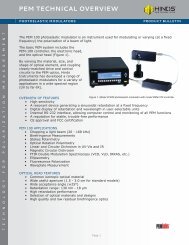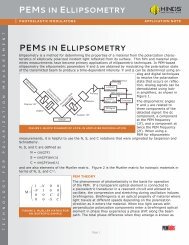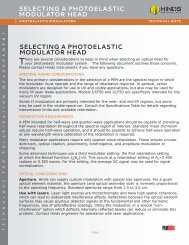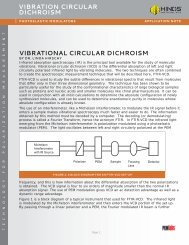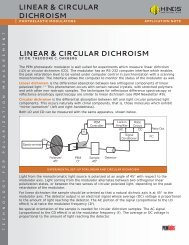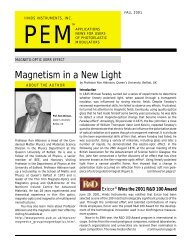A PEM-based Stokes Polarimeter for Tokamak ... - Hinds Instruments
A PEM-based Stokes Polarimeter for Tokamak ... - Hinds Instruments
A PEM-based Stokes Polarimeter for Tokamak ... - Hinds Instruments
Create successful ePaper yourself
Turn your PDF publications into a flip-book with our unique Google optimized e-Paper software.
HINDS INSTRUMENTS,INC.3175 NW ALOCLEK DRIVEHILLSBORO, OR 97124 USABULK RATEUS POSTAGE PAIDHillsboro, ORPermit number 76PHONE: 503/690.2000FAX: 503/690.3000TOLL FREE: 1.800/68 8.4 4 6 3EMAIL: info@hindspem.comWEB SITES: www.hindspem.comwww.exicor.comReturn service requestedINSIDE <strong>PEM</strong><strong>PEM</strong>-<strong>based</strong> <strong>Stokes</strong> <strong>Polarimeter</strong>Dual <strong>PEM</strong> SystemsHINDS Teams With SEMATECH©2002, <strong>Hinds</strong> <strong>Instruments</strong>, Inc.Printed in USA. BB/4M/07-02(continued from page 4)HINDSTeams WithSEMATECHFigure 5.IntrinsicBirefringenceof CaF2at157nmTo respond to this issue, <strong>Hinds</strong> has extended its corecompetency in low-level visible birefringence measurements todevelop a system to characterize birefringence in any opticalmaterial transparent at 193 nm or 157 nm. We were awarded acontract with SEMATECH to expedite the development of theDUV birefringence measurement system. They have tasked<strong>Hinds</strong> to provide the semiconductor industry with measurementmetrology <strong>for</strong> QC, as well as lab R&D use, <strong>for</strong> characterizing theinteraction between DUV light and CaF2in lithography imagingsystems.Data from a prototype DUV birefringence measurementsystem was reported at International SEMATECH’s 157nmTechnical Data Review this May in Dallas, TX. One of our seniorapplication scientists, Dr. Bob Wang, showed 2-D images as wellas contour maps which vividly displayed both the magnitudeand corresponding fast axis angle of residual and the recentlydiscovered intrinsic <strong>for</strong>m of birefringence in CaF2at 157 nm.An example is shown in Figure 5. This data represents the firstmultidimensional characterization of CaF 2’s birefringence at157 nm resulting from our collaboration with SEMATECH.Dr. Wang’s preliminary findings, measured at different crystalorientations, confirmed high levels of intrinsic birefringence.Furthermore, the 2-D birefringence maps of the entire surfacesof CaF2cubic samples measured at the (110) orientationdemonstrated significant variation in birefringence, possiblydue to residual birefringence in those samples. Lower levels ofbirefringence, with significant variation in magnitude andangle, were also observed <strong>for</strong> the (001) orientation.One design solution that has been proposed to reducethe intrinsic birefringence at 157 nm is to couple lenses inthe imaging system at offsetting orientations. Dr. Wangdemonstrated the validity of this approach. He presented datafrom two stacked cubes that had the same orientation (110)with a resulting total mean birefringence of 54 nm. When oneof the cubes was rotated by 90°, the total birefringence wasdrastically reduced to below 1 nm/cm.<strong>Hinds</strong> is aggressively pursuing the development of a DUVbirefringence measurement system and has an engineeringmodel in development. A commercial system capable ofmeasuring samples as large as 400 mm diameter x 270 mm thickis scheduled to be available during the second half of 2002.6




